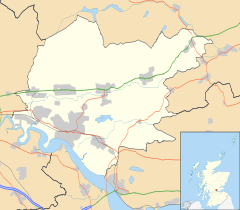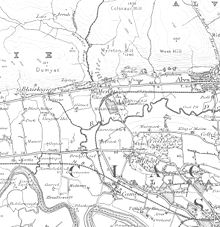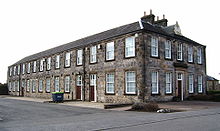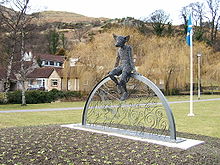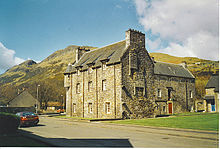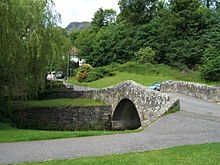- Menstrie
-
Coordinates: 56°09′03″N 3°51′16″W / 56.15085°N 3.85438°W
Menstrie Scottish Gaelic: Meanstraidh
 Menstrie shown within Clackmannanshire
Menstrie shown within ClackmannanshirePopulation 2,640 OS grid reference NS852969 Council area Clackmannanshire Lieutenancy area Clackmannanshire Country Scotland Sovereign state United Kingdom Post town Menstrie Postcode district FK11 Dialling code +44 (0) 1259 Police Central Scotland Fire Central Scotland Ambulance Scottish EU Parliament Scotland UK Parliament Ochil and South Perthshire Scottish Parliament Ochil List of places: UK • Scotland • Menstrie (Meanstraidh in Scottish Gaelic) is a village in the county of Clackmannanshire in Scotland, UK. It is about 5 miles (8 kilometres) east-north-east of Stirling. It is one of a string of towns that, because of their location at the base of the Ochil Hills, are collectively referred to as the Hillfoots Villages or simply The Hillfoots.
Contents
Physical geography
Menstrie stands on the carse or flood plain of the River Devon, between 10 and 20 metres altitude above sea level. It is roughly astride the Ochil Fault whose movement gave rise to the dramatic southern scarp of the Ochils but which is now almost quiescent.
Two of the most westerly summits of the Ochil Hills, Dumyat and Myreton Hill, rise steeply to the north of the village to reach about 400m altitude. These two hills are divided by Menstrie Glen, from which the small watercourse of Menstrie Burn emerges and runs through the village. About a kilometre to the south, the burn joins the River Devon which in turn meets the River Forth at Cambus.
Facilities
The village has a general store (containing the Post Office), a pharmacy, two pubs (The Holly Tree and the Burnside Inn) and a petrol station. Menstrie also has a library, small sports centre, public park, primary school, a residential establishment for older people [1] and two churches; one being Menstrie Parish Church (Church of Scotland) and the other being of the United Free Church of Scotland.
Transport links
Menstrie is on the A91 road from Stirling to St Andrews. Bus services run to Stirling via Stirling University, to Alloa via Alva and Tillicoultry or via Tullibody, and less frequently to St Andrews. Beginnining in late 2010, bus services also run to Clackmannan and to Falkirk (the Falkirk District Royal Infirmary) via Alloa.
Industry and population
A conspicuous zig-zag roadway up the scarp face of Myreton Hill, nowadays used by the local sheep farmer for access to his livestock, was originally built during the Napoleonic Wars for access to some mine workings, which produced calcite. However, the volume of material mined was rather small in proportion to the effort needed to build the road, so the venture is unlikely to have been economic. There seems to be no record of why calcite was considered to be sufficiently valuable to have justified the considerable effort.
The occupants of Menstrie once processed wool from sheep farmed on the Ochils. In 1800, businessmen from Tullibody set up a carding and spinning mill on the east side of the Menstrie Burn to exploit its soft water and power, absent from their own village.
In the early 19th century a straight road was built on the flat ground of the carse or floodplain to by-pass the old Hillfoots Road and improve the transport of goods to and from the Hillfoots villages. Menstrie's Long Row and Ochil Road lie on the old route along the foot of the hills. The new road, now the A91, became a focus for construction of churches, houses, mills and shops.
By the mid-19th century, the Elmbank and Forthvale mills were in business on either side of the Menstrie Burn.
In 1841, Menstrie's population was about 500 but had increased to more than 900 by 1881.[2]
In the 1860s, a company which included the owners of local mills and a distillery, financed a branch railway line through Menstrie to a terminus in Alva. [3] This joined the old North British Railway (N.B.R.) line between Alloa and Stirling at Cambus. Menstrie had its own passenger station at the North end of Tullibody Road. Practically nothing of the station remains and the railway branch line, which continued to carry freight after the Beeching Axe, fell into disuse during the mid-1980s in favour of road transport.
The Glenochil Distillery had opened in the middle 18th century on the site of the Doll Farm to the east of the village, beside the Dams Burn. Manufacturing has continued on this site for more than 250 years though production of whisky stopped around 1930. Yeast, initially a by-product of whisky fermentation, had gradually become the main product and went for manufacture of whisky and bread. Soft water, locally available, is still useful. An extensive bonded warehouse area remains for storage of whisky as it matures in barrels before bottling, while bakers' yeast has given way to fermentation products derived from yeast.
The whisky and yeast businesses are now operated by separate companies, respectively: Diageo, (successors to Distillers Company); and Kerry Group. The latter conducts product development as well as manufacturing at the Menstrie site.
The Forthvale Mill no longer stands but the Elmbank Mill, [4] having been used for some years as offices by the Water Board, now houses small businesses.
A furniture factory, The Charrier, stood near the Menstrie Burn but was destroyed by fire in about 1968. A street nearby now bears its name.
In the mid-20th Century, Menstrie (pop. 1200 - 1300) [5] was home to families whose menfolk worked the Clackmannanshire Coalfield and other mines in Central Scotland.
As the mining and textile industries have declined, Menstrie has become a commuter dormitory, spreading over the adjacent farmland. At the Census in 2001 Menstrie's population was 2011 [6] and had increased to an estimated 2640 by the middle of 2008.[7]
Recreation
Menstrie's Scout Group was established in 1908.[8]
Menstrie is popular with hillwalkers; along with Blairlogie it is situated at the foot of Dumyat, a popular peak in the Ochil Hills. Myreton Hill is much used by paragliders.
The disused railway line served as an unofficial walking route to Tullibody over the bridge across the River Devon. In October 2007 Clackmannanshire Council published [9] a map [10] which designated part of the railway line, by then heavily overgrown, as an Aspirational Core Path linking Menstrie and Cambus. By February 2010 the branch line had been sold by BRB (Residuary) Limited [11] and by March 2011 the rails and sleepers had all been removed.
"Fox Boy", a work by the sculptor Andy Scott, stands in Midtown Gardens in the centre of Menstrie. It combines references to the water wheels that once powered industry in Menstrie, a pet fox kept by a Menstrie child years ago,[12] and the buzzards that frequent the skies over the village.
Architecture and housing
Menstrie Castle was the birthplace of Sir William Alexander, James VI’s Chartered Lieutenant for the Plantation of Nova Scotia. Despite its name, it is described as a "three-storey castellated house",[13] and lacks many fortified features, standing as it does on low ground and constructed at a time of relative national calm. The building is now residential [14] and has won a Civic Trust award.
The old (pre-19th century) bridge over the Menstrie Burn is listed by The Royal Commission on the Ancient and Historical Monuments of Scotland under number 219364.[15]
In 1874 [16] James Johnstone, one of the partners in the Elmbank Mill, had built for himself the Scottish baronial-style Broom Hall on the lower slope of Myreton Hill. It was burned out in the 1940s[17] and stood as an abandoned shell until 1985 when it was converted into a nursing home. It has since been refurbished as a restaurant.
As a commuter town Menstrie has undergone a period of expansion since 2000, with new housing built to the west and south of the village. The firm responsible for maintenance of common areas around the new housing is currently (spring 2011) in dispute with an association of residents.[18] The residents complain that: the maintenance work fails to meet standards stated in the deeds; that the charges are excessive; and that the company has resorted to excessively heavy-handed methods to extract payment, accusations the company rejects.[19]
In December 2009, Clackmannanshire Council announced an alteration to the local development plan for housing land.[20][21] This allowed for construction of 175 new housing units, including 36 termed 'affordable', to the south-east of the village. The Council subsequently modified the plan as recommended by a Reporter appointed by Scottish Ministers. In the absence of further directions from the ministers, the council formally adopted the modified plan in the autumn of 2011. Among other stipulations and guidelines the modified plan as adopted allowed for 175 housing units, 43 affordable; and required a detailed Flood Risk Assessment to determine ground conditions and water management needs on and for the site.[22]
Towns and villages Alloa · Alva · Cambus · Clackmannan · Coalsnaughton · Devonside · Dollar · Fishcross · Forestmill · Glenochil · Inglewood · Kennet · Menstrie · Muckhart · Sauchie · Solsgirth · Tillicoultry · TullibodyReferences
- ^ http://www.clacksweb.org.uk/social/menstriehouse/ Menstrie House, Clackmannanshire Council Social Services
- ^ http://www.scottish-places.info/towns/towndetails198.html The Gazetteer for Scotland, population estimates: 1841, 1881
- ^ http://www.railbrit.co.uk/Alva_Railway/frame.htm RAILSCOT: History of the Alva railway branch
- ^ http://canmore.rcahms.gov.uk/en/site/47139/details/menstrie+elmbank+mill/ RCAHMS: Menstrie, Elmbank Mill
- ^ http://www.scottish-places.info/towns/towndetails198.html The Gazetteer for Scotland, population estimates: 1951, 1961
- ^ http://www.clacksweb.org.uk/property/developmentplan/appendices/population/ Clackmannanshire Council Development Planning
- ^ http://www.gro-scotland.gov.uk/files2/stats/population-estimates/08mye-localities-table1.pdf Mid Year 2008 Population Estimates for Localities in Scotland: General Register Office for Scotland (GROS) website
- ^ http://www.menstrie.org/sg200803.html Menstrie Scout Group announces Centenary Celebrations
- ^ http://www.clacksweb.org.uk/site/documents/countryside/candidatecorepathsmaps/ Clackmannanshire Council Documents & Publications - Countryside
- ^ http://www.clacksweb.org.uk/document/1176.pdf Clackmannanshire Council Map of Candidate Core Paths near Menstrie and Tullibody
- ^ http://www.brb.gov.uk/property/property_listings?keyword=clackmannanshire BRB (Residuary) Limited: Properties in Clackmannanshire
- ^ http://www.menstrie.org/mb200906.html#foxboy Letter to "Menstrie Matters", June 2009
- ^ History of Menstrie Castle: MenstrieCastle.co.uk website. Retrieved on January 13, 2008
- ^ http://www.scottisharchitects.org.uk/building_full.php?id=411804 Dictionary of Scottish Architects' entry for Menstrie Castle
- ^ "Menstrie Old Bridge". The Royal Commission on the Ancient and Historical Monuments of Scotland, no. 219364. http://www.scotlandsplaces.gov.uk/search_item/index.php?service=RCAHMS&id=219364.
- ^ http://www.scottisharchitects.org.uk/building_full.php?id=212343 Dictionary of Scottish Architects' entry for Broomhall
- ^ http://canmore.rcahms.gov.uk/en/site/139094/details/menstrie+long+row+broomhall/ RCAHMS: Menstrie, Long Row, Broomhall
- ^ http://scotlandonsunday.scotsman.com/scotland/Residents-refuse-to-pay-39unfair39.6150266.jp Residents refuse to pay 'unfair' garden firm fees: Scotland on Sunday, 14 March 2010
- ^ http://www.wee-county-news.co.uk/index.php?option=com_content&task=view&id=678&Itemid=56 Pensioners hit out at factors: Wee County News, 26 February 2008
- ^ http://www.clacksweb.org.uk/document/2569.pdf The Clackmannanshire Local Plan, First Alteration (Housing Land): Clacksweb.org.uk website
- ^ http://www.clacksweb.org.uk/document/2561.pdf Clackmannanshire Council Local Plan Map for Menstrie dated December 2009
- ^ http://www.clacksweb.org.uk/document/3373.pdf The Clackmannanshire Local Plan, First Alteration (Housing Land), Adopted, October 2011, plan ref. H50: Clacksweb.org.uk website
External links
Categories:- Hillfoots Villages
- Towns in Clackmannanshire
Wikimedia Foundation. 2010.

